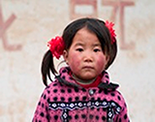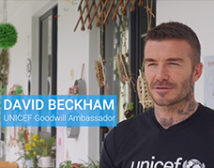Tusunhan Oxwy, a member of China's Uygur minority living in Kashgar, still recalls the scenes of “big-necked patients” in far northwestern China.
“They used to be ubiquitous here,” says Tusunhan, 55, who has served as village medic for 38 years. “Now you seldom see a kid or an adult with goiter. It's mainly because of the campaign by regional government and UNICEF to help local people consume more iodized salt.” Tusunhan says the 850 farmers in his village are goiter-free. Landlocked in Eurasia's hinterland, Xinjiang gets most of its water from glaciers. With very low iodine content in the soil and water, the region historically has been plagued by the “big neck disease” and by cretinism, both caused by iodine deficiency disorders (IDD). Out of a population of 19 million, 1.28 million people suffered goiter in the 1980s and 12,000 were victims of cretinism, according to Wang Shaohua, deputy director of the regional health bureau.
By 1995, the occurrence of goiter among Xinjiang children aged 8 to 10 was above 43 percent. “IDD, the region's number-two killer after tuberculosis, had caused a goiter endemic,” says Wang.
Although many Uygur farmers know about the dangers of IDD, they continue to use salt without iodine because it is cheaper. In the region's poorest areas such as southern Xinjiang, public health experts have found it impossible to promote iodized salt by administrative fiat. Even the few households that buy iodized salt tend not to consume it, using it only to show visiting health inspectors.
Many Uygurs salt their food by melting salt bricks in water and adding the salty water to food when cooking. The bricks contain almost no iodine, but they're cheap. Local doctors have addressed the economics behind the problem by developing an iodine-release that can be dropped into the water in which salt bricks are melted.
“We had to figure out a way for local people to increase their iodine intake,” says Wang Shaohua, a public health official. “So far, the iodine-release device has proven the most effective method. For a family of five, it only costs three yuan a year, about one-tenth the price of a year's worth of iodized salt.”
Since 2000, the Xinjiang government has spent 1.2 million yuan (US $144,600) on 600,000 devices for 300,000 households, Wang says. About 1.5 million people in southern Xinjiang have benefited from the devices.
One of them is Kuwanhan Sit, 36. She and her three children are lucky compared to her mother-in law, 60, whose tubercular goiter is so big and hard it looks like rock hanging underneath her chin.
“In the past, we could not consistently use iodized salt because of the cost,” she says. “Now we are using the iodine-release device, which is very convenient. The village medic and leaders from the region told us raw salt is no good for kids. Kids could lose their learning ability if there is no iodine in their food.”
Xinjiang began its efforts to eliminate IDD years before its collaboration with UNICEF-China was launched in 2000. “We started addressing the problem after the State Council issued its Regulations on Iodized Salt Control for IDD in 1994,” says Wang Shaohua. “We set up a government-controlled sales network in 10 prefectures and 83 cities and rural communities throughout Xinjiang.”
For newly married women, the government provides iodine oil shots to prevent cretinism and other IDD-related diseases in newborns. One injection can satisfy a woman's iodine demand for three to five years. Of Xinjiang's 300,000 women of childbearing age, 270,000 have yearly injections.
The tremendous effort has paid off handsomely. Coverage of iodized salt intake has improved greatly, jumping from 63 percent in 1996 to 88 percent in 2002, and the incidence of goiter among children aged 8 to 10 fell below 15 percent in 2003.
Nevertheless, says Wang Shaohua, “We still have a long way to go in comparison with other provinces and regions.” Figures from the Ministry of Health indicate Xinjiang is one of areas, most of them in the west, that are still struggling to reach Universal Salt Iodination—defined as more than 90 percent of households consuming iodized salt—the UN goal the set at the Summit for Children in 1990. The rest of the country realized the goal in 2000. In Xinjiang, 35 out of 96 counties have yet to catch up.
Eliminating IDD requires political commitment. “No politician with a big vision should ignore or neglect the problem,” Wang says. “Protecting children today ensures the well-being of future generations.”
By Wen Chihua, China Features




























